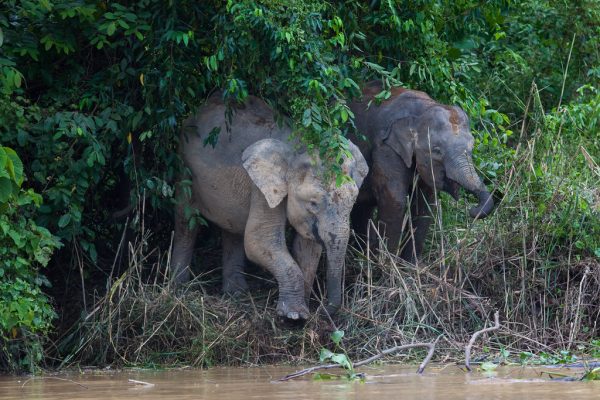ASIAN ELEPHANT

KEY FACTS Population Trend: Decreasing ↓
IUCN Status: Endangered
around 2,100 – 3,100 individuals left in the wild
Scientific name: Elephas maximus
Size: upto 2.7m (height), up to 6.5m (length)
Found in: Peninsular Malaysia and East Malaysia
Habitat: Grasslands, dense tropical evergreen forest, dry and wet deciduous forest and shrub lands
Diet: Grass, bark, roots, leaves and the stems of trees and shrubs
Average number of calf: one (every 4 years)
Average Life-expectancy in the wild: up to 60 years
DESCRIPTION
The Asian elephant—revered for centuries as a cultural and religious icon—is the only living species of the genus Elephas found in Asia. Moreover, the Borneo elephant, or the Borneo pygmy elephant, is a subspecies of Asian elephant that is found in northeastern Borneo, Indonesia, and Malaysia. Although Asian elephants are not quite as big as their African cousins, they are still the largest living land animal in Asia. They are easily distinguished by their smaller, rounded ears.
Female elephants usually can be observed in herds with their female relatives. In contrast, adult male Asian elephants are mostly solitary, but they can sometimes form loose associations with other males, especially younger individuals. The Asian elephants are highly intelligent animals, displaying a wide array of social behaviours including compassion, mimicry, grief, altruism, and self-awareness. Their most unique feature: the trunk is actually composed of the nose and upper lip. Moreover, it contains over 40,000 different muscles and has several uses: smelling the faintest scent, breathing, communicating with other individuals, drinking, pushing trees to grab food, and as a defense.
Historically, Asian elephants once roamed across most of Asia and were found in large numbers throughout the Malay Peninsula. However, over the past 100 years, rainforests have been cut down and cleared for human development, leading to a decline in the wild elephant population and a considerable rise in human-elephant conflict. Today, around 2,100 to 3,100 individuals are left in the wild in Malaysia. Current threats to wild Asian elephant populations include habitat loss and degradation and illegal wildlife trafficking.
For a deeper understanding of elephant rehabilitation and conservation efforts, check these insightful articles: What Makes a Good Elephant Rehab in Asia? and The Conservation of Asian Elephants in Southeast Asia.





